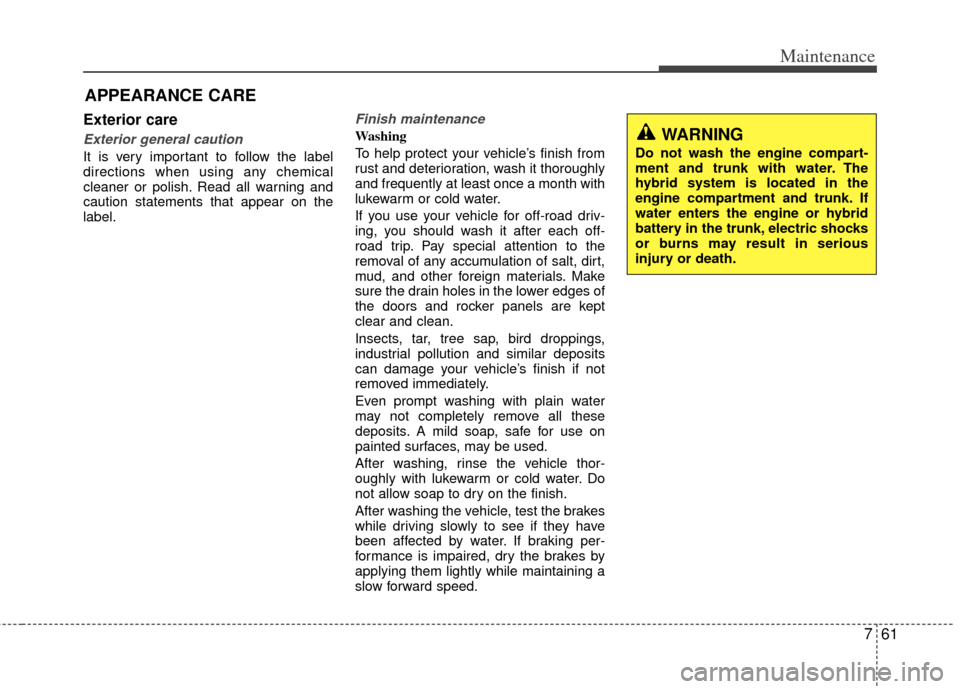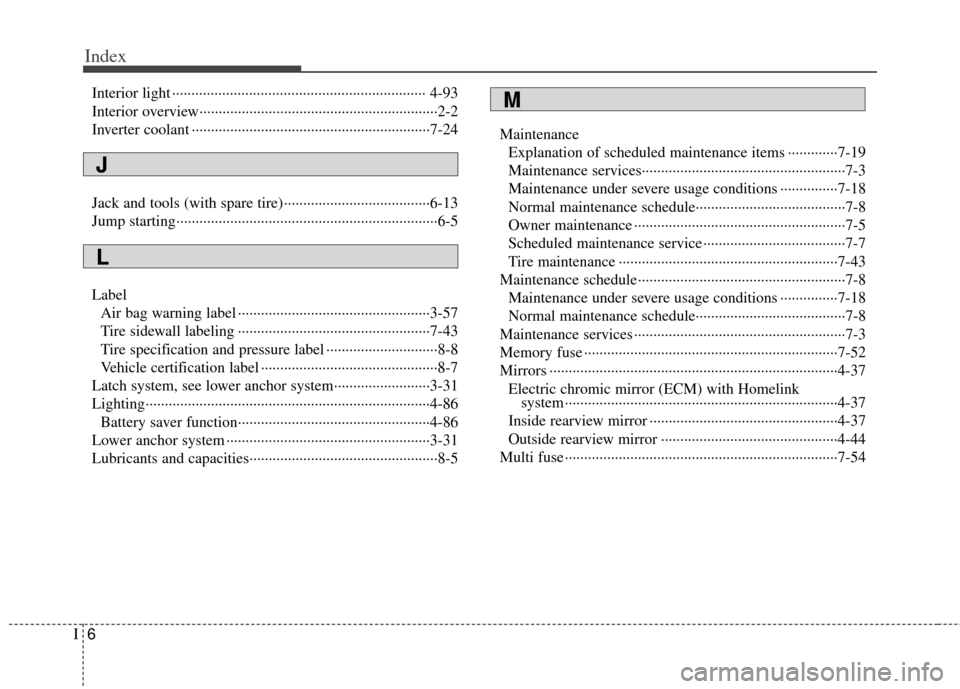2011 KIA Optima Hybrid warning light
[x] Cancel search: warning lightPage 299 of 394

Maintenance
67
At least monthly:
Check the coolant level in the enginecoolant reservoir.
Check the operation of all exterior lights, including the stoplights, turn sig-
nals and hazard warning flashers.
Check the inflation pressures of all tires including the spare.
At least twice a year (i.e., every Spring and Fall) :
Check the radiator, heater and air con- ditioning hoses for leaks or damage.
Check the windshield washer spray and wiper operation. Clean the wiper
blades with clean cloth dampened with
washer fluid.
Check the headlight alignment.
Check the muffler, exhaust pipes, shields and clamps.
Check the lap/shoulder belts for wear and function.
Check for worn tires and loose wheel lug nuts.
At least once a year :
Clean the body and door drain holes.
Lubricate the door hinges and checks,and hood hinges.
Lubricate the door and hood locks and latches.
Lubricate the door rubber weather- strips.
Check the air conditioning system.
Check the power steering fluid level.
Inspect and lubricate automatic transaxle linkage and controls.
Clean the battery and terminals.
Check the brake fluid level.
Check the drive belt.
Page 344 of 394

751
Maintenance
FUSES
A vehicle’s electrical system is protected
from electrical overload damage by
fuses.
This vehicle has 2 fuse panels, one locat-
ed in the driver’s side panel bolster, the
other in the engine compartment near
the battery.
If any of your vehicle’s lights, acces-
sories, or controls do not work, check the
appropriate circuit fuse. If a fuse has
blown, the element inside the fuse will
melt.
If the electrical system does not work,
first check the driver’s side fuse panel.
Always replace a blown fuse with one of
the same rating.
If the replacement fuse blows, this indi-
cates an electrical problem. Avoid using
the system involved and immediately
consult an authorized Kia dealer.
Three kinds of fuses are used: blade typefor lower amperage rating, cartridge type,and multi fuse for higher amperage rat-ings.
✽ ✽ NOTICE
The actual fuse/relay panel label may
differ from equipped items.
WARNING - Fuse replace-
ment
Never replace a fuse with any-
thing but another fuse of the
same rating.
A higher capacity fuse could cause damage and possibly a
fire.
Never install a wire or aluminum foil instead of the proper fuse -
even as a temporary repair. It may
cause extensive wiring damage
and a possible fire.
CAUTION - Fuse
replacement
Do not use a screwdriver or anyother metal object to remove fuses because it may cause a short circuitand damage the system.
OLM079051N
Normal
Normal
Blade type
Cartridge type
Multi fuse
Main fuse Blown
Blown
Normal Blown
Normal Blown
Page 346 of 394

753
Maintenance
✽
✽NOTICE
• If the memory fuse is pulled up from
the fuse panel, the warning chime,
audio, clock and interior lamps, etc.,
will not operate. Some items must be
reset after replacement. Refer to
“Battery” in this section.
• Even when the memory fuse is pulled up, the battery can still be discharged
by operation of the headlights or other
electrical devices.
Engine compartment panel fuse
replacement
1. Turn the ignition switch and all other switches off.
2. Remove the fuse box cover by press- ing the tap and pulling up the cover.
3. Check the removed fuse; replace it if it is blown. To remove or insert the fuse,
use the fuse puller in the engine com-
partment fuse panel.
4. Push in a new fuse of the same rating, and make sure it fits tightly in the clips.
If it fits loosely, consult an authorized
Kia dealer.
CAUTION - Fuse panel
covers
After checking the fuse panel in theengine compartment, securely install the fuse panel cover to pre-vent electrical failures which mayoccur from water leaking in.
OTF070020
Page 354 of 394

761
Maintenance
APPEARANCE CARE
Exterior care
Exterior general caution
It is very important to follow the label
directions when using any chemical
cleaner or polish. Read all warning and
caution statements that appear on the
label.
Finish maintenance
Washing
To help protect your vehicle’s finish from
rust and deterioration, wash it thoroughly
and frequently at least once a month with
lukewarm or cold water.
If you use your vehicle for off-road driv-
ing, you should wash it after each off-
road trip. Pay special attention to the
removal of any accumulation of salt, dirt,
mud, and other foreign materials. Make
sure the drain holes in the lower edges of
the doors and rocker panels are kept
clear and clean.
Insects, tar, tree sap, bird droppings,
industrial pollution and similar deposits
can damage your vehicle’s finish if not
removed immediately.
Even prompt washing with plain water
may not completely remove all these
deposits. A mild soap, safe for use on
painted surfaces, may be used.
After washing, rinse the vehicle thor-
oughly with lukewarm or cold water. Do
not allow soap to dry on the finish.
After washing the vehicle, test the brakes
while driving slowly to see if they have
been affected by water. If braking per-
formance is impaired, dry the brakes by
applying them lightly while maintaining a
slow forward speed.WARNING
Do not wash the engine compart-
ment and trunk with water. The
hybrid system is located in the
engine compartment and trunk. If
water enters the engine or hybrid
battery in the trunk, electric shocks
or burns may result in serious
injury or death.
Page 377 of 394

H6Starting the Hybrid System
1. Carry the smart key into the vehicle.
2. Make sure the parking brake is firmly
applied.
3. Place the shift lever in the P(Park) position.
In N (neutral) position, you can not
start the vehicle.
4. Depress the brake pedal.
5. Press the engine start/stop button.
6. The engine should be started without pressing the accelerator. In extremely
cold weather or after the vehicle has
not been operated fro several days, let
the engine warm up without depress-
ing the accelerator.
• Even if the smart key is in the vehicle,if it is far away from you, the engine
may not start.
in the ACC or ON position, if any door
is open, the system checks for the
smart key. If the smart key is not in
the vehicle, the warning, "Key is not
in vehicle" will come on, and if all
doors are closed, the chime will also
sound for about 5 seconds. The indi-
cator will turn off while the vehicle is
moving. Keep the smart key in the
vehicle when using the ACC position
or if the vehicle engine is on.
If the starting procedure is followed,
the "READY" symbol on the instru-
ment cluster will turn on. For more
details, Please check chapter 5.
ECONOMICAL and SAFE OPERA-
TION of Hybrid system
Drive smoothly. Accelerate at a mod- erate rate and maintain a steady cruis-
ing speed. Don't make "jack-rabbit"
starts. Don't race between stoplights.
Avoid heavy traffic whenever possible.
Always maintain a safe distance from
other vehicles so you can avoid unnec-
essary braking. This also reduces
brake wear.
The regenerative brake generates energy when the vehicle decelerates.
When the hybrid battery power is low, the hybrid system automatically
recharges the hybrid battery.
When the engine runs in "N" position, the hybrid system cannot generate
electricity. The hybrid battery cannot
recharge in "N" position. Please refer
to chapter 5.
STARTING THE HYBRID VEHICLE (SMART KEY)
Page 387 of 394

Index
2I
Air bags··················\
··················\
··················\
··················\
··3-34Air bag warning label ··················\
··················\
··············3-57
Air bag warning light ··················\
··················\
··············3-37
Curtain air bag ··················\
··················\
··················\
·······3-49
Driver's and passenger's front air bag··········\
················3-45
Occupant detection system ··················\
··················\
······3-40
Side impact air bag ··················\
··················\
··················\
3-48
SRS components and functions ··················\
·················3-38\
Air cleaner ··················\
··················\
··················\
···············7-30
Air conditioning ··················\
··················\
··················\
·········8-2
Antenna (glass) ··················\
··················\
··················\
······4-117
Anti-lock brake system (ABS) ··················\
··················\
··5-18
Appearance care ··················\
··················\
··················\
····· 7-61 Exterior care ··················\
··················\
··················\
··········7-61
Interior care ··················\
··················\
··················\
···········7-66
Armrest ··················\
··················\
··················\
··················\
··3-15
Audio system ··················\
··················\
··················\
·········4-117 Glass antenna ··················\
··················\
··················\
·······4-117
Steering wheel audio control ··················\
··················\
·4-118
Automatic climate control system ··················\
···············4-96 Air conditioning ··················\
··················\
··················\
··4-103
Climate control air filter ··················\
··················\
········4-106
Economy air conditioning ··················\
··················\
·····4-104
Heating and air conditioning ··················\
··················\
···4-98 Automatic transaxle ··················\
··················\
··················\
···5-9
Shift lock system ··················\
··················\
··················\
···5-13
Aux, USB and iPod port ··················\
··················\
··········4-119
Battery··················\
··················\
··················\
··················\
····7-35
Battery··················\
··················\
··················\
··················\
······8-2
Battery saver function ··················\
··················\
················4-86
Before driving ··················\
··················\
··················\
············5-3
Bottle holders, see cup holders ··················\
··················\
4-113
Brake system··················\
··················\
··················\
············5-14 Anti-lock brake system (ABS) ··················\
··················\
5-18
Electronic stability control (ESC) ··················\
·············5-20
Hill-start assist control (HAC) ··················\
··················\
5-23
Parking brake ··················\
··················\
··················\
·········5-16
Power brakes··················\
··················\
··················\
··········5-14
Brakes fluid··················\
··················\
··················\
··············7-28
Bulb wattage ··················\
··················\
··················\
··············8-3
Button start/stop, see engine start/stop button ·················5-5
A
B
Page 391 of 394

Index
6I
Interior light ··················\
··················\
··················\
············ 4-93
Interior overview··················\
··················\
··················\
········2-2
Inverter coolant ··················\
··················\
··················\
········7-24
Jack and tools (with spare tire) ··················\
··················\
··6-13
Jump starting··················\
··················\
··················\
··············6-5
LabelAir bag warning label ··················\
··················\
··············3-57
Tire sidewall labeling ··················\
··················\
··············7-43
Tire specification and pressure label ··················\
···········8-8
Vehicle certification label ··················\
··················\
··········8-7
Latch system, see lower anchor system··················\
·······3-31
Lighting··················\
··················\
··················\
··················\
··4-86 Battery saver function··················\
··················\
··············4-86
Lower anchor system ··················\
··················\
·················3-31\
Lubricants and capacities··················\
··················\
·············8-5 Maintenance
Explanation of scheduled maintenance items ·············7-19
Maintenance services·············\
··················\
··················\
····7-3
Maintenance under severe usage conditions ···············7-18
Normal maintenance schedule··················\
··················\
···7-8
Owner maintenance ··················\
··················\
··················\
·7-5
Scheduled maintenance service ··················\
··················\
·7-7
Tire maintenance ··················\
··················\
··················\
···7-43
Maintenance schedule··················\
··················\
··················\
7-8 Maintenance under severe usage conditions ···············7-18
Normal maintenance schedule··················\
··················\
···7-8
Maintenance services ··················\
··················\
··················\
·7-3
Memory fuse ··················\
··················\
··················\
············7-52
Mirrors ··················\
··················\
··················\
··················\
···4-37 Electric chromic mirror (ECM) with Homelink system ··················\
··················\
··················\
·················4-37\
Inside rearview mirror ··················\
··················\
·············4-37
Outside rearview mirror ··················\
··················\
··········4-44
Multi fuse ··················\
··················\
··················\
·················7-54\
J
L
M